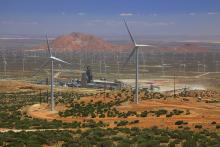Concrete buildings, pavements and structures are silently absorbing carbon dioxide (CO2) from the air, making the built environment one of the world’s largest storehouse of carbon.
This is the main message from peer-reviewed scientific studies summarised in a paper released by researchers at CalPortland.
The paper, Incorporating the Effect of Carbonation in Concrete Life Cycle Assessment, says having a better appreciation of CO2 uptake can aid the development of better strategies to mitigate the impacts of climate change.
Allen Hamblen, CEO of CalPortland, says: “It is time to further examine the value of concrete in the built environment as a significant carbon sink. To do so accurately, we must specifically look at the net effects of CO2 sequestration in concrete and evaluate all structures over their lifetime within a circular economy.”
CalPortland insists that focused studies on CO2 uptake in concrete within the context of its overall Life Cycle Assessment are necessary in order to understand the effects of greenhouse gases associated with the built environment.
A study from the Swedish Environmental Research Institute examined data from several European countries to develop practical models to gauge the extent of CO2 uptake by concrete globally in the built environment.
The researchers developed several approaches and statistical models of increasing complexity to come up with valid estimates of general CO2 uptake by concrete.
The Tier 1 model provides a simplified approach for use on a national basis relative to the annual emissions associated with cement production in the same year. It has two options for the calculation of CO2 uptake. Option A uses the mean value of 20% for estimating uptake of CO2 over the life of concrete structures. Option B uses this mean value minus a standard deviation factor for estimating CO2 uptake resulting in 15% uptake.
The standard deviation adjustments are designed to account for various factors that could affect the rate of carbonation. These include the length of time of exposure to the atmosphere, humidity, porosity of the concrete, cement type and water to cement ratios.
The production of Portland cement, an ingredient of concrete, is identified as a major contributor to greenhouse gas emissions. CO2 emissions occur when calcium carbonate, the main component of limestone, is exposed to intense heat as part of the cement production process. These emissions come from both the burning of fuels used to heat the cement kiln and from the CO2 released from the raw carbonates used to make cement. This process is called calcination.
The process of calcination is not chemically stable and therefore is reversible. CO2 in the atmosphere reacts with the hydrated cement in concrete and carbonates are regenerated. Exposed concrete in the built environment absorbs carbon dioxide through the reaction of CO2 with concrete compounds resulting in CaCO3, the main component of limestone. This reaction permanently removes CO2 from the atmosphere and binds it in a stable state within concrete. This process is called carbonation.
Considerable attention has been paid to quantifying the industrial process emissions from cement production, however the natural reversal process of the uptake of CO2 during concrete’s complete material life phases is just beginning to receive the consideration it deserves.
A copy of the full paper is available here.





